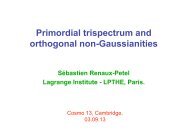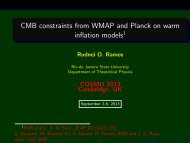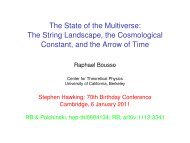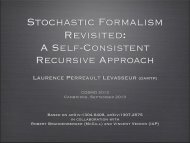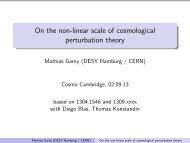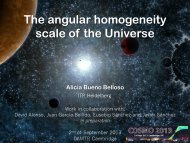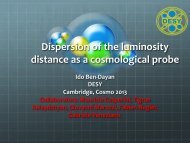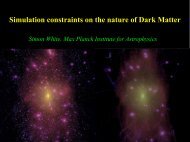Cosmological constant problem and equivalence principle of ...
Cosmological constant problem and equivalence principle of ...
Cosmological constant problem and equivalence principle of ...
Create successful ePaper yourself
Turn your PDF publications into a flip-book with our unique Google optimized e-Paper software.
<strong>Cosmological</strong> Constant Problem <strong>and</strong>Equivalence Principle <strong>of</strong> Quantum GravityH.M.MokRHU, Hong Kong SAR,CHINAa8617104@graduate.hku.hk
<strong>Cosmological</strong> Constant Problem• The vacuum energy behaves as the term in the Einstein’s field equationR g R/2 g = 8GT known as the cosmological <strong>constant</strong>.• The cosmological <strong>constant</strong> <strong>problem</strong> is that- Why the observed value so many order <strong>of</strong> magnitude smaller than thatexpected in quantum field theories?- Why it is <strong>of</strong> the same order <strong>of</strong> magnitude as the matter density <strong>of</strong> theuniverse at the present time?• We have shown in the previous paper (arXiv:astro-ph/0105513) that ifthe space-time behaves as the phase <strong>of</strong> Higgs condensate <strong>and</strong> is discretein nature, the vacuum energy could be extremely large in microscopicscale but comparatively very small in macroscopic scale.
Solution <strong>of</strong> the <strong>Cosmological</strong>Constant Problem• This is analogous to the situation that the mass density inside theatomic nucleus (10 18 kg/m 3 ) is extremely larger than the mass density<strong>of</strong> common material (~10 3 kg/m 3 ) in the length scale <strong>of</strong> our daily life• Under such hypothesis, the microscopic vacuum energy density micro should be averaged over the condensate in macroscopic scale<strong>and</strong> the cosmological <strong>constant</strong> can be found asλ = 8πG macro = m 7 /(π 2 M p5) ~ (m EW ) 7 /(M p ) 5By putting m EW = 100 GeV, the value <strong>of</strong> the cosmological <strong>constant</strong> isthen equal to 10 -52 [m] -2 which corresponds to about 0.7 <strong>of</strong> the criticalmass density <strong>of</strong> the universe.• This result is in excellent agreement with the recent cosmologicalobservations.
Evolution <strong>of</strong> the Universe• The results also show that the cosmological <strong>constant</strong> depends on theVEV <strong>of</strong> the Higgs condensate <strong>and</strong> the cosmological <strong>constant</strong> for thePlanck stage <strong>and</strong> GUT stage can be estimated as (M p ) 2 <strong>and</strong>(m GUT ) 7 /(M p ) 5 respectively.• The time <strong>of</strong> which the universe changed from deceleration toacceleration in the Planck, GUT <strong>and</strong> Electroweak stage can be foundas 10 -42 s, 10 -27 s <strong>and</strong> 8 billion years <strong>of</strong> the universe respectively.• The time calculated for the universe changed from deceleration toacceleration at about 8 billion years is in excellent agreement withthe recent cosmological observations (Riess, A.G. et al 2004 ApJ).
Evolution <strong>of</strong> the Universe• The above mentioned relationship between matter density <strong>and</strong>cosmological <strong>constant</strong> also explains why the matter density <strong>of</strong> thepresent epoch is similar in the order <strong>of</strong> magnitude as vacuum energydensity. Therefore, the cosmological <strong>constant</strong> <strong>problem</strong> can be solved.• The above results indicate that the nature <strong>of</strong> cosmological <strong>constant</strong>would be fundamentally related to the quantum nature <strong>of</strong> space-time.The development <strong>of</strong> quantum gravity theory plays an important role forthe quest <strong>of</strong> cosmological <strong>constant</strong> <strong>problem</strong>.
Equivalence Principle <strong>of</strong> General Relativity• In this talk, we would further explore the underlying physical meaning<strong>of</strong> the space-time condensate hypothesis by introducing the<strong>equivalence</strong> <strong>principle</strong> <strong>of</strong> quantum gravity which would be thefundamental <strong>principle</strong> for the unification <strong>of</strong> the general relativity <strong>and</strong>quantum mechanics.• In general relativity, the laws <strong>of</strong> physics must be <strong>of</strong> such a nature thatthey apply to systems <strong>of</strong> reference in any kind <strong>of</strong> motion.• The general laws <strong>of</strong> nature are to be expressed by the equations whichhold good for all systems <strong>of</strong> co-ordinates, that is, are covariant withrespect to any substitutions whatever (i.e. generally covariant).
Review on Physical Meaning <strong>of</strong>Space-time• In relativity, the space-time is relative to the observer frame which isdefined by the coordinate system established by measuring-rods <strong>and</strong>synchronized clocks at rest relative to the observer for the descriptions<strong>of</strong> physical events.• However, the quantum mechanical measuring device as an observerframe (i.e. quantum mechanical frames) are not considered in special<strong>and</strong> general relativity. Thus, the classical relativity is not valid inquantum mechanical frames.• In essence, this is the fundamental difficulties in unifying generalrelativity with quantum mechanics in conception level.• Then, what do the physical laws behave as observed in quantummechanical frames <strong>of</strong> reference ?
Equivalence Principle <strong>of</strong> Quantum Gravity• The fundamental <strong>principle</strong> <strong>of</strong> relativity is that there is no preferredreference frame <strong>and</strong> the physical laws are valid in reference frame inany kind <strong>of</strong> motion.• We expect that such basic <strong>principle</strong> is also valid for quantummechanical frame <strong>of</strong> reference. That means it is not possible for anobserver to know whether he is in a quantum frame or not by physicalexperiments.• Therefore, the <strong>equivalence</strong> <strong>principle</strong> <strong>of</strong> general relativity should beextended such that the meaning <strong>of</strong> any kind <strong>of</strong> motion shall alsoinclude the quantum mechanical motions• We propose that the <strong>equivalence</strong> <strong>principle</strong> <strong>of</strong> quantum gravity is that“The laws <strong>of</strong> physics must be <strong>of</strong> such a nature that they apply tosystems <strong>of</strong> reference in any kind <strong>of</strong> motion, both classical <strong>and</strong> quantummechanical ”
Equivalence Principle <strong>of</strong> Quantum Gravity• Apparently, such extension <strong>of</strong> <strong>equivalence</strong> <strong>principle</strong> is not possiblesince the quantum mechanical effects depends upon the particle masses.That means the law <strong>of</strong> quantum mechanics for different particle massesvaries with the energy scale <strong>of</strong> the quantum frame <strong>of</strong> reference.• However, the ordinary space-time concept requires to be changed since,in quantum space-time measurements, the energy scale should also bespecified to determine the measurement uncertainty.• As we learned in relativity, we have to refer to the actual physicalmeasurements <strong>of</strong> an observer in defining the space-time.• The quantum frame <strong>of</strong> reference is therefore not just kinematical as inrelativity but dynamical. It requires to include mass energy scale as aparameter for its determination.
Equivalence Principle <strong>of</strong> Quantum Gravity• This could lead to a space-time-matter geometrical structure which isthe suitable space for the <strong>equivalence</strong> <strong>principle</strong> <strong>of</strong> quantum gravity.The quantum mechanical frames would be described by this spacetime-matterstructure <strong>and</strong> it could be known as the quantum space-time.• Furthermore, the extended <strong>equivalence</strong> <strong>principle</strong> provides a strongfundamental symmetry for quantum gravity.• Under the <strong>equivalence</strong> <strong>principle</strong>, the quantum mechanical effects <strong>of</strong>particles can be varied by choosing the quantum mechanical frames <strong>of</strong>different energy scale.• Analogous to the concept <strong>of</strong> free fall frame in general relativity, onecould choose a quantum frame <strong>of</strong> reference for a quantum particle suchthat it behaves as a classical particle <strong>and</strong> general relativity holds for it.
Equivalence Principle <strong>of</strong> Quantum Gravity• In such frame, the product <strong>of</strong> the space-time increment ds <strong>and</strong> massscale m provides a local scale invariant quantity mds in quantummechanics (ħ = c =1) which is the expression <strong>of</strong> space-time length interms <strong>of</strong> ratio <strong>of</strong> Compton wavelength <strong>of</strong> a particle.• The quantum mechanical effects become relative to the quantum frame<strong>of</strong> reference. Moreover, quantum mechanical properties <strong>of</strong> particles isdue to the effects <strong>of</strong> quantum space-time as analogous to gravity ingeneral relativity.
Equivalence Principle <strong>of</strong> Quantum Gravity• Based on the local scale invariance nature <strong>of</strong> the <strong>equivalence</strong> <strong>principle</strong>,physical measurements in quantum frame <strong>of</strong> reference <strong>of</strong> differentenergy scale should associated with scale changes.• That is analogous to the space <strong>and</strong> time measurements in curved spacetimein general relativity.
<strong>Cosmological</strong> Constant in Quantum Gravity• Under the <strong>equivalence</strong> <strong>principle</strong>, the classical <strong>and</strong> quantum mechanicalpicture, or say deterministic <strong>and</strong> probabilistic picture, are both validrepresentation <strong>of</strong> the physical phenomena <strong>and</strong> could be transformedfrom each other by the quantum frame <strong>of</strong> reference.• Under the <strong>equivalence</strong> <strong>principle</strong>, the theory <strong>of</strong> quantum gravity isbackground independent as there is no preferred frame <strong>of</strong> reference.And the classical picture for particles is a local equivalentrepresentation <strong>of</strong> the quantum mechanical ones.
Summary• The fundamental hypothesis that the space-time behaves as the phase <strong>of</strong>Higgs condensate <strong>and</strong> discrete in nature provides the explanation <strong>of</strong> thecosmological <strong>constant</strong> <strong>problem</strong> by the averaged vacuum energy density <strong>of</strong>the space-time condensate.• It shows that the nature <strong>of</strong> cosmological <strong>constant</strong> would be fundamentallyrelated to the quantum nature <strong>of</strong> space-time.• The space-time condensate hypothesis is further explained by introducingthe <strong>equivalence</strong> <strong>principle</strong> <strong>of</strong> quantum gravity <strong>and</strong> it leads to the local scaleinvariance symmetry <strong>of</strong> the theory.• The property <strong>of</strong> the cosmological <strong>constant</strong> that it is very large inmicroscopic scale but very small in macroscopic scale is the characteristics<strong>of</strong> quantum space-time under the <strong>equivalence</strong> <strong>principle</strong>.
Summary• Under the <strong>equivalence</strong> <strong>principle</strong>, the theory <strong>of</strong> quantum gravity isbackground independent <strong>and</strong> the classical picture for particles is a localequivalent representation <strong>of</strong> the quantum mechanical ones.• The above results reveal that our approach is on the right track <strong>and</strong> isworth pursuing in that direction.



